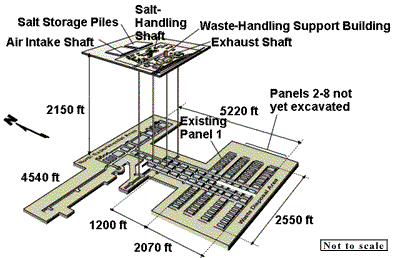One of the purposes of my blog is to cover breaking stories that have to do with nuclear problems. Some of these posts deal with specific events that can be covered in a single post. Others are more complex and require several posts. In still other situations, there is an ongoing story where new information keeps emerging as the situation evolves. The repercussions of the radiation release at the Waste Isolation Pilot Plant (WIPP) near Carlsbad, New Mexico are an example of the third kind of story. I have already posted several times about WIPP as more and more information emerges. They are still not sure that they understand how the radiation was released.
My last post had to do with the theory that a new absorbent was added to drums of transuranic waste from Los Alamos National Laboratory. (LANL) The new absorbent did not perform as well as the old absorbent to solidify liquid waste in the drums and lock up ammonium nitrates. This may have led to nitrate salts precipitating out of solution and crystallizing. Such nitrate salts are unstable and generate heat which may have ruptured a drum to release radiation. There are hundreds of drums with the new absorbent at WIPP that may be at risk. A hundred of these drums from LANL are in temporary storage in Texas. If any of them rupture, the release of radiation could be much worse than occured at WIPP.
Now a new theory is emerging from LANL emails. A LANL contractor requested permission to use new chemicals to neutralize the pH in the drums. One chemical reacted with acids in the drums and the other reacted with bases. The contractor explicitly states in the email that he is not an expert on safety issues and he requests that LANL experts review the safety of the new chemicals. It is unknown at this time if anyone at LANL did, in fact, check to see if the use of the new chemicals would be safe. Some scientists say that the new chemicals are known to cause oxidation reactions that generate heat when combined with some of the substances in the drums. This may have been what ruptured the drum at WIPP.
Now we have two different possible reasons that a the contents of a drum would heat up and cause it to rupture. In both cases, a new substance was added to these drums of plutonium waste from nuclear weapons production. Over five hundred drums of their waste contain these new chemical and are a risk. Because of the radiation release and the uncertainty over the cause, WIPP is closed. There are estimates that it may take as much as two years to seal off the dangerous drums before the facility can reopen. In the meantime, more waste is piling up at LANL which will cause it to fail to meet a deadline for waste disposal. It is still an open question as to whether or not anyone with the necessary expertise actually investigated to find out whether these new chemicals could cause problems. At the very least, this is serious negligence on the part of LANL.
Diagram of Waste Isolation Pilot Plant:
